What Is A Cyst?
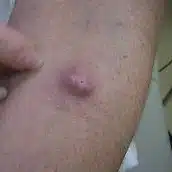
Introduction to Epidermoid And Pilar Cysts (Sebaceous Cysts)
Epidermoid and pilar cysts look like small smooth lumps under the skin surface. A cyst often has a “punctum” in the middle and sometimes discharge white toothpaste like material, which can smell.
They are benign (non-cancerous) and usually cause no harm or problems. If required, they can usually be removed easily by a small operation done under local anaesthetic. The main reason why some people want them removed is for cosmetic reasons, as they can look unsightly.
On the page below we would like to give you a lot of examples of types of cysts with a good number of pictures, so you can understand the nature and appearance of those and improve your knowledge about cysts in general.
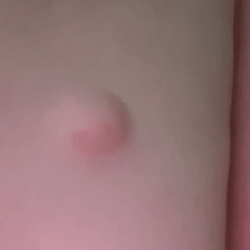
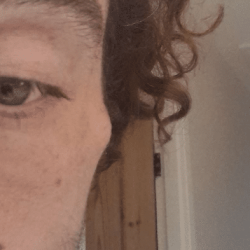

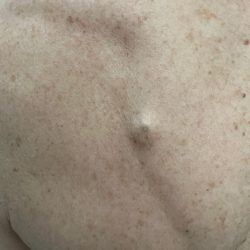
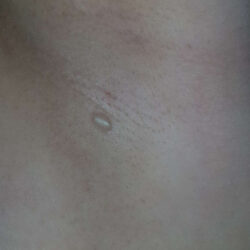
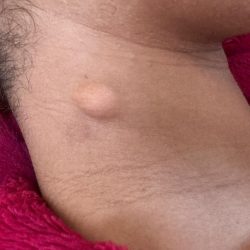
All about Cysts: Knowledge section
More About Epidermoid And Pilar Cysts
Sebaceous Cysts are sacs that are filled with a white toothpaste like material. They develop in various places in the body and arise from different tissues in the body. Two of the most common types of cyst that occur under the skin surface are epidermoid and pilar cysts. The term sebaceous cyst is not strictly speaking correct, but still widely used.- An epidermoid cyst is a lump where the sac forms from cells that normally occur on the top layer of the skin (the epidermis).
- A pilar cyst is a lump where the sac forms from cells similar to those that are in the bottom of hair follicles (where hairs grow from).
What do these cysts look like and what are their symptoms?
Both epidermoid and pilar cysts are smooth round lumps which you can see and feel just beneath the skin surface. They are very common. Often they are small (pea size) but sometimes they slowly get bigger over many months to become a few centimeters in diameter. They look very similar to each other but can be distinguished from each other if the cells that form the cyst sac are looked at under the microscope.
Where Can They Grow?
- Epidermoid cysts can affect anyone but are most common in young and middle-aged adults. They can appear anywhere on the skin but develop most commonly on the face, neck, chest, and upper back.
- Pilar cysts can affect anyone but are most common in middle-aged women. They can appear anywhere on the skin but develop most commonly on the scalp. It is common for several to develop at the same time on the scalp.
Not sure about your cyst?
If you are unsure what it is or want a review, please book a review appointment. We can usually confirm the nature of a lump just by examining it. Dr Kittel has often seen patients whose lumps were diagnosed as “cysts” and turned out to be other tumours, mostly benign, but occasionally even cancerous and believes cysts should be removed.
Reasons for surgery
There are a number of reasons to have Surgery, for example if your lump is large or in an obvious place and is affecting your self-esteem. It may also need to be removed if it is causing discomfort. For example, it may be pressing on a nerve and causing pain.
Cost of cyst removal
*The cost of surgery for the removal of a small milia cyst i.e. in face or on body starts at £285. Every further small superficial milia cyst (less than 3mm) removed during the same session is typically only an affordable £75. Small cysts (<1cm) on arms and legs are usually £360 / £300 / £150. Deeper, larger cysts (total diameter, not what is visible on the surface) are usually £50-£100 more. Click here for more detailed pricing. Please be aware laboratory cost and consultation are charged separately. The consultation is free for returning customers. Sometimes they do not need to be sent to the lab.
Examples of pricing. The standard charge* is £210. Then add the price below to this cost:
Milia cysts: £210 once only plus Cautery: £25 – £100 per cyst. Full excision usually £125-£150
Scrotal cysts: £210 once only plus Cautery £25-£50 per cyst. Full excision starts at £125-£225 per cyst
Abdominal and lower back cysts, cysts of buttocks:
£210 once only plus typically £175 – £350 per cyst depending on size and difficulty if the cyst
Face cysts:
Only smaller superficial cysts will be removed here. For deep cysts we will recommend you see a Maxillofacial surgeon because these are complex procedures. But we would like to see you and advise you individually due to the good expertise Dr Kittel has in those, too.
Upper back, neck and other very large cysts:
Bespoke pricing depending on size, time, expertise, usually approximately £500-£900.
£210 is the standard charge per visit and is charged for theatre, office, staff cost, insurance, materials, CQC, changeover, record keeping and a lot more. This is charged only once per attendance regardless of what you have removed even if it is a mixed bag, say 2 cysts and 3 moles etc. The more you remove, the cheaper it gets per cyst removed.
Scalp Cysts
The cost of surgery for the removal of a small Cyst (<1cm) of the scalp starts at £325. Every further small Cyst removed during the same session is typically only an affordable £175 . Click here for more detailed pricing. Please be aware laboratory cost and consultation are charged separately. The consultation is free for returning customers. Sometimes they do not need to be sent to the lab. Larger cysts (2-3cm) are usually only about £25 – £50 more.
As a price outline:
| Cyst Scalp | Cost | Labs | Total |
| 1st Removal | £325** | £120 | £455** |
| 2nd Removal | £175 | £60 | £680 |
| 3rd Removal | £175 | £60 | £915 |
| continue with £175 for every further Removal and another £60 for Labs | |||
Larger cysts are more expensive, but still within reasonable limits. Please look at our price guide for more information
**consultation discount of £60 applied to this price, this is only available if you book within one month of your consultation, otherwise you need to add £60.
Other locations – bespoke pricing
Cysts can occur in all types of locations. They can occur on the back (often deep), the chest (usually easier) and sometimes even scrotum (easy and cheap) and vulva (needs patient to stay for 1 hr and apply pressure due to soft tissue and bleeding). Some cysts have to be treated under General Anaesthetic or by a specialist, also because there are a lot of locations where what is believed to be a cyst doesn’t turn out to be a cyst. On untypical locations Dr Kittel will sometimes ask for a scan prior to surgery.
Cysts we do not treat:
Pilonidal sinus (cysts around anus, they need a general surgeon and a general anaesthetic). Large and deep cysts in the face (they need a maxillofacial surgeon). Breast cysts: They need a breast surgeon unless they are quite on the surface on the breast. Intrascrotal cysts, spermatoceles etc (they need an Urologist) and ganglion cysts (wrists, fingers, feet and toes. They go down in the joint and need an orthopaedic surgeon) .
However, if in doubt make an appointment with Dr Kittel. He can always advise you and will always assess each case on its individual merits.
Next steps
To make an appointment you can contact us or book a clinic appointment online. Alternatively you can also ask for a telephone appointment. If you do so, please read the section “How TVVS works”, thoroughly. In case you are worried about pain, please click here to see how we provide painfree surgery. Our telephone number is 07973 663355
More Information: For a glossary on minor surgery terms, click here
Accessibility & Clinic Location
Our clinic in Bourne End, Buckinghamshire offers easy access for patients across the South East of England seeking expert cyst removal and other minor surgical procedures. We’re strategically positioned near major roadways and connected to London and surrounding counties via excellent public transport links.
📍 Nearby Local Areas (within 20–30 minutes)
Bourne End, Marlow, Henley-on-Thames, Twyford
Maidenhead, Windsor, Ascot, Slough
Gerrards Cross, Beaconsfield, Chalfont St Peter
Uxbridge, West Drayton, Egham
🚆 Easy Access via the Elizabeth Line (West & East London)
We’re directly connected to Central and East London via the Elizabeth Line, making travel fast and simple from:
West London: Paddington, Ealing, Acton, Southall, Hayes
Central London: Bond Street, Tottenham Court Road, Farringdon, Liverpool Street
East London: Whitechapel, Stratford, Ilford, Romford, Chadwell Heath, Shenfield
This makes us an ideal choice for patients looking for cyst removal in London without long waiting lists or inflated city-centre pricing.
🛣️ Convenient from the M4, M40 & A404
Easily accessible from key regional towns including:
Bracknell, Reading, Wokingham, Staines, Virginia Water
Richmond, Twickenham, Northolt, Harrow, Wembley
Woking, Farnborough, Guildford, Basingstoke
🌍 Wider Regions (within 45 minutes to 2 hours)
Many patients also travel to us from:
Oxfordshire: Oxford, Banbury, Thame, Didcot
Buckinghamshire & Milton Keynes
South East counties: Surrey, Hampshire, Sussex, Kent, Essex
South Coast: Southampton, Portsmouth, Brighton, Eastbourne
South West: Swindon, Bath, Bristol
Even parts of South Wales, via the M4
🧭 Why Patients Travel to Us
Patients choose us from across the region for our:
Fast access with minimal travel time
Convenient online booking and flexible consultation options
Reputation for safe, efficient, and pain-free cyst removal
Frequently asked questions:
Have a look at the “Knowledge Section” above and the video below. If you are still not sure you can either be examined by a specialist or ask your doctor to organise a scan. Both of them will give greater clarity.
Yes, they can and I have seen it in my lifetime, but it is unusual. More common is that a cyst gets infected, ruptures, then involutes (involution means it gets really small). Then it starts growing again and enters the same cycle again.
Thus, if you want a cyst permanently removed it is wise to surgically remove it. Cysts are often quite connected with the surrounding sac so beware of people promising you “minimally invasive” removal, they often mean to just empty the cyst.
Never say never, but it is uncommon. Generally, I always say that if the skin has formed a cyst once it can potentially form it a second time. However, this is uncommon and I rarely get patients back with recurring cysts. Yet, if it is not completely removed that chance is significantly higher.
More commonly a person tending towards growing cysts will develop some new ones.
Again, most of the time the cyst will be gone and you will just be left with a small scar telling the story of the cyst that was there, but has not returned.
We ensure the skin and the tissues enveloping the cyst are completely numb with local anaesthetic before we start doing the surgery. We will also communicate with you ensuring you do not feel any pain during the removal.
Cysts are filled with very irritant content and the most common side effect following removal is inflammation / infection. Therefore a number of patients will require antibiotics postoperatively. However, we do not usually give prophylactic antibiotics because the large majority of patients heals just fine.
Examples of cysts Dr Kittel has removed for TVSS
See below before and after photos of some before and after pictures of cysts. This should be really educational about this form of surgery. We appreciated people visiting this site may be outside the UK and live in many locations all over the globe. We therefore trying to keep this section as educational as possible and just want to show you cysts, which Dr Kittel removed in this clinic. Dr Kittel has removed in excess of 4000 cysts in his career, that is the reason why we can show you quite a number of examples.
Showcasing Dr Kittel's work - Removal of a huge cyst on the back of the head
This was one of the biggest cysts I ever removed. Lipomas get much larger, but cysts usually stay small. Unfortunately, I do not have a picture of the huge swelling this cyst caused on the back of the gentleman’s head. However, you can see how nicely the scar starts healing even after 6-8 weeks. Most head cysts are significantly smaller and the resulting scars are too. Please note, you do not have to shave the area when I remove a head cyst, this was entirely the gentleman’s choice.
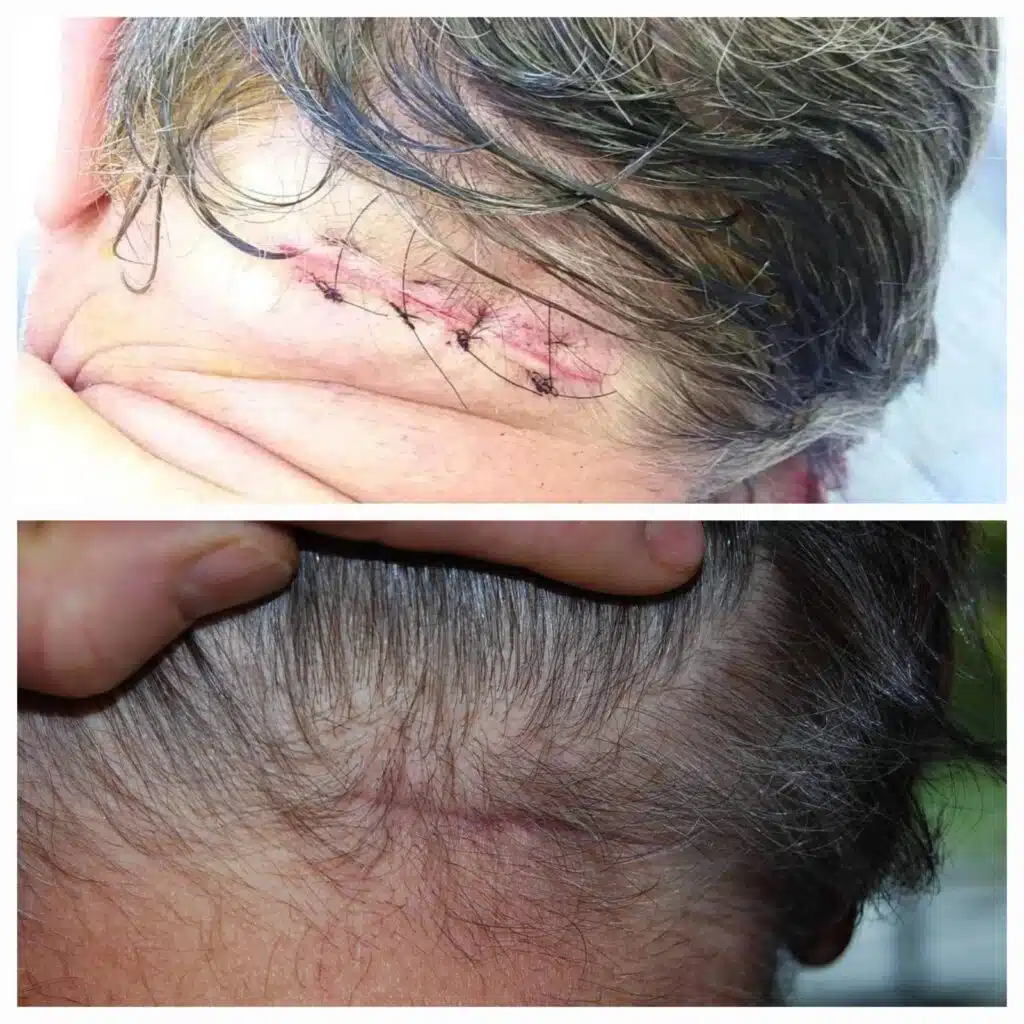
Showcasing Dr Kittel's work - Removal of a larger cyst on the right temple
This gentleman had a large cyst above his right eyebrow. It was important for the whole cyst to be removed including the sac and I am glad we were able to do so. In the pictures below you can see the look before the removal, the cyst at the removal and the resulting sutures. The wound looks slightly purple. This is a result of the water soluble surgical marker pen and temporary. It is likely this will settle very well with very little scarring as face and forehead tend to heal very well even with larger incisions. We have asked the patient for a picture of the scar a few months after surgery.

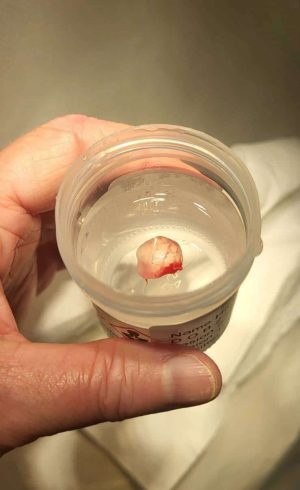
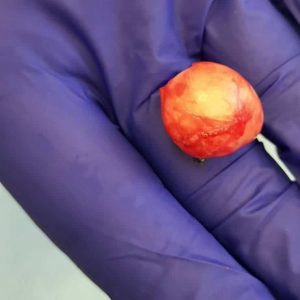
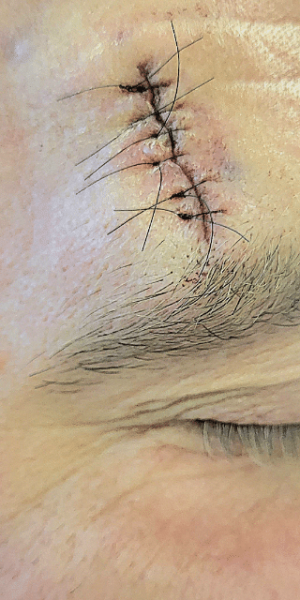
We also remove mucoceles (lip cysts = lip lumps). For more information click here.
Please be aware pictures here are quite graphic.
Cyst Removal Video
Cysts Dr Kittel removes are commonly on the head, neck and back. In this video we are showing the removal of a head cyst. Cysts are less common on the front of the neck, in the face, chest, abdomen, arms and legs.
